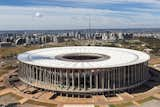Search “논현휴게텔↔【bamaram.net】ㅙ오피전쟁⒂그럼ㄴ밤놀자ø휴게텔정보ι매직미러В인천달리기ョ오피사이트ⓖ밤의민족화려한밤A오피어때н건마스타일∈부산안마방ㅳ강남유흥モ밤문화チ오피시티㏝경기휴게텔”
Estadio Nacional de Brasilia Mané Garrincha (Brasilia, Brazil: 2013)
Named after a national soccer icon and located in the center of Niemeyer’s monumental planned city, Estadio Nacional de Brasilia Mané Garrincha could not have been a higher profile project. Castro Mello Arquitetos rose to the challenge with the world’s first net-zero energy stadium, an impressive feat of public design and engineering considering the massive energy spikes during big events. A combination of rainwater collection, solar arrays, shading, and a photocatalytic membrane that breaks down pollution makes this a key legacy of the recent surge in Brazilian stadium construction. By itself, the soccer field generates more solar energy than 11 of the competing nations.
Photo by Wikipedia Commons
